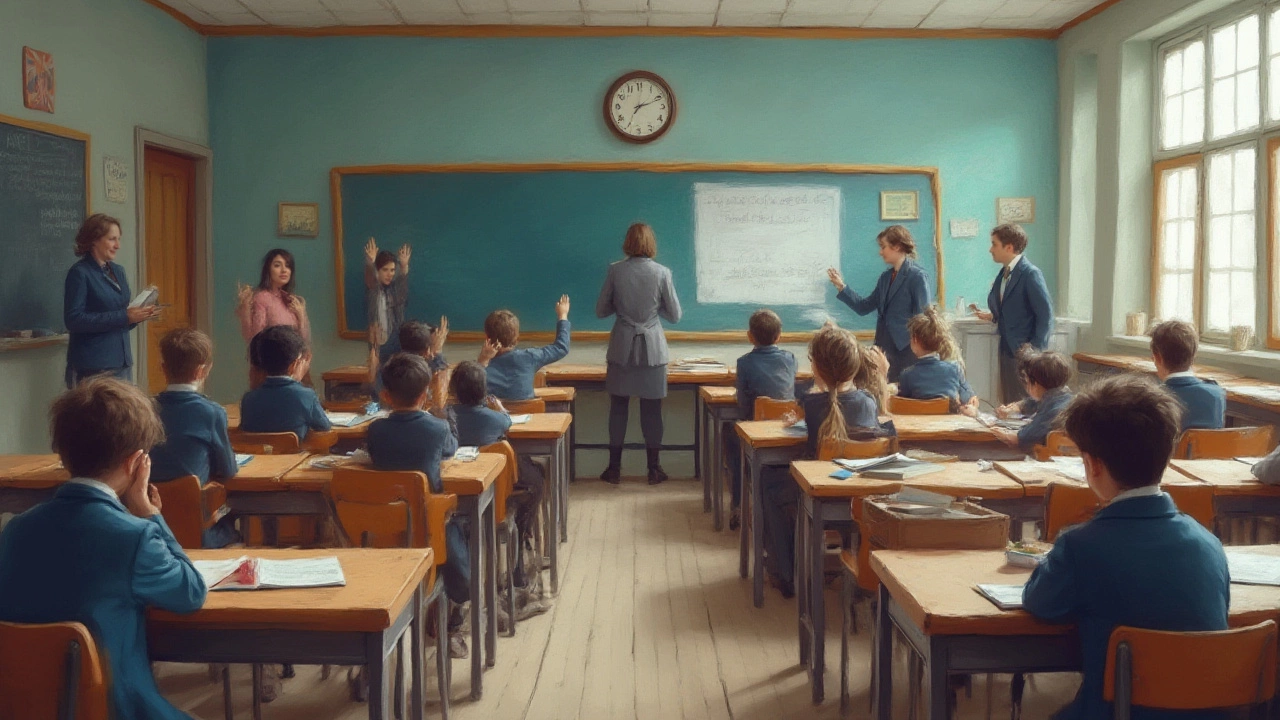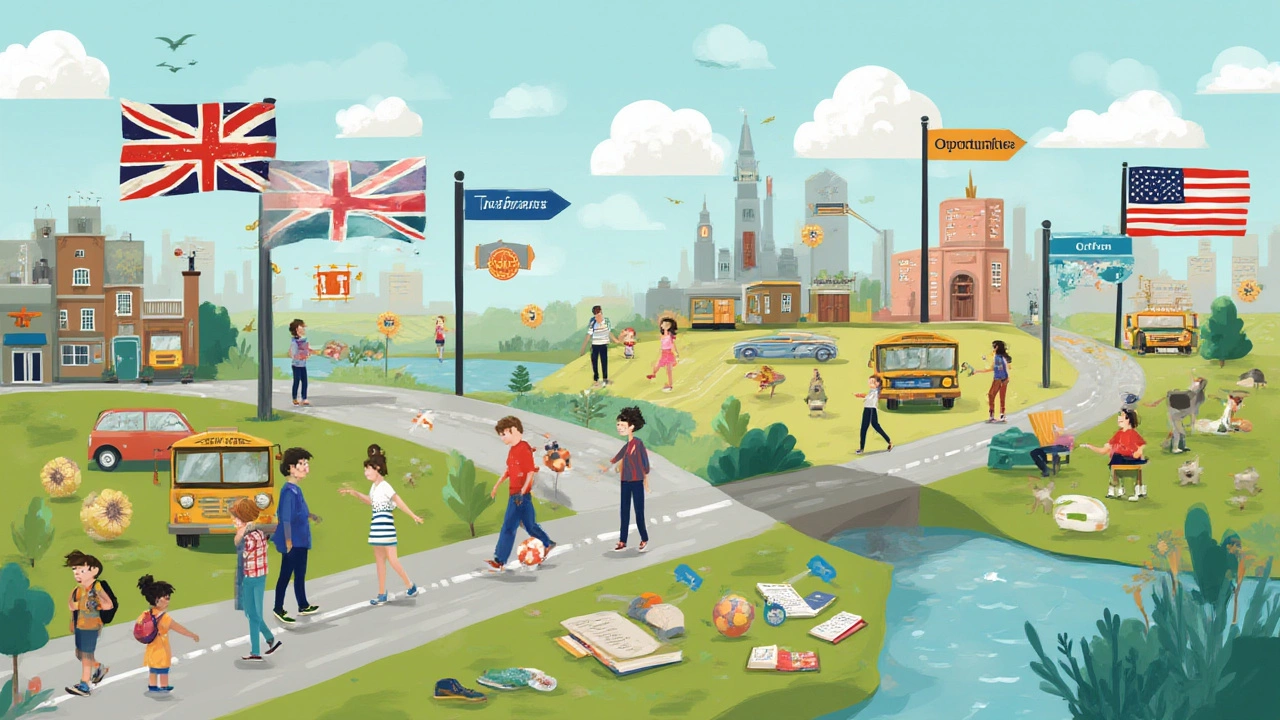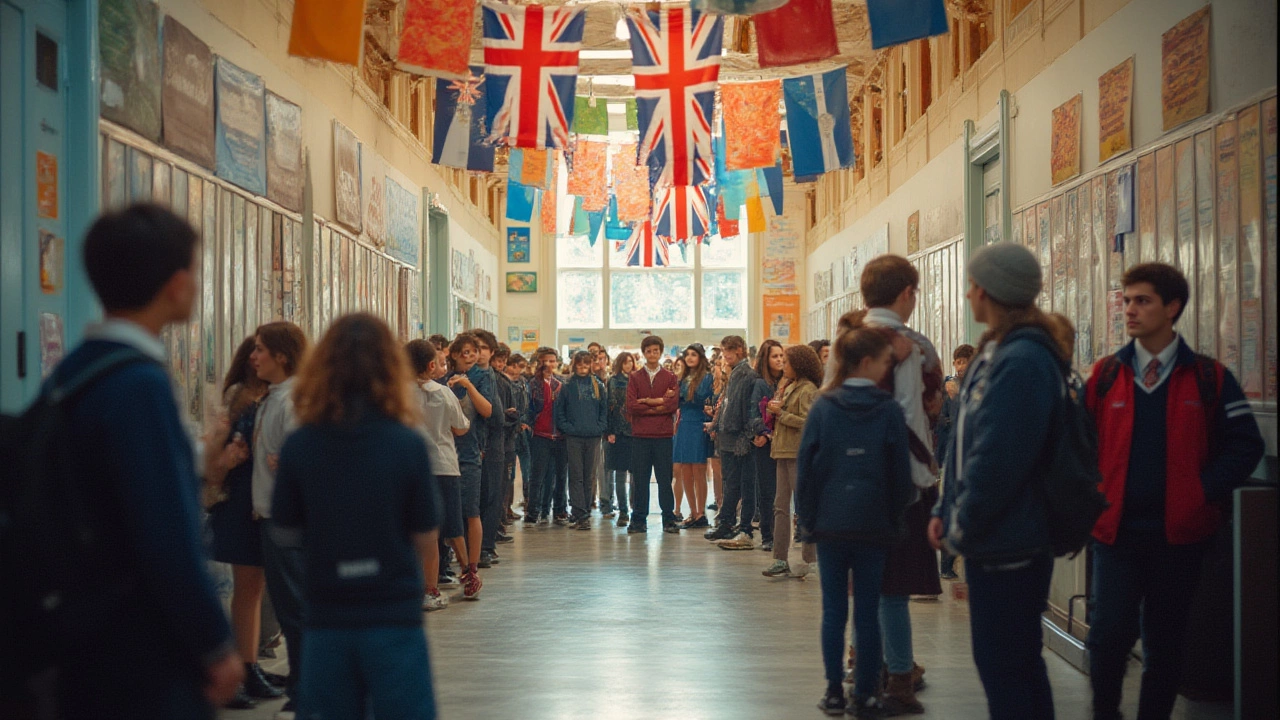Imagine rocking up to your first day of high school only to find out you call your teacher "Sir,” wear an actual blazer, and someone’s talking about “taking A-levels.” Or maybe you end up with a locker, join a marching band, and attend “homeroom.” The differences between American and British schools aren't just quirky—they shape your whole experience, right down to what and how you learn, who you become friends with, and the careers you’ll aim for. While the debate is hot—Americans often say their system encourages independence, Brits love their longstanding traditions—there’s more to the story than stereotypes or what you see in movies. If you’re eyeing a move, or just curious because your mate’s swapping Adelaide for Boston or Bristol, here’s a deep dive into how these two giants stack up.
How American and British Schools Structure Education
American schools stretch from Kindergarten through to Grade 12, with most kids starting around age 5 and popping out the other end at 18. There’s elementary, then middle, then high school—each with its own vibe. British students, on the other hand, start with Reception, move through 'Primary', and then tackle 'Secondary'. What throws people is that British kids finish ‘compulsory’ school at 16 (after their GCSE exams), while Americans are still buckling down for another two years of high school. The British route gives a weird but exciting choice—end full-time school (load up on apprenticeships, or jump into work), or stay for “Sixth Form” to take A-levels, which gets you uni-ready.
Schools in America tend to be bigger. Suburban high schools can have thousands of students, multiple sports fields, entire wings for art or science. British schools, especially in smaller towns or cities, can be cozier—500-1,000 kids max. That smaller scale gives a close-knit vibe, but big schools can swallow you if you don’t find your people. If you like lots of choices—AP classes, drama club, lacrosse—American schools usually have you covered, because bigger means more options. British students sometimes feel boxed in, choosing three or four A-level subjects at age 16, and dropping all the rest. Americans typically juggle a wider range of subjects right up till Grade 12—math, English, science, history, arts —you name it.
Assessment style is a big divider. Americans are used to frequent homework, pop quizzes, and midterm exams—grades stack up through assignments and participation, not just tests. Brits, on the other hand, stare down all-or-nothing exams at the end of their courses, with little else feeding into their final marks. Everyone dreads the British ‘finals’—years of work can ride on a handful of tests written over a couple of weeks. Some love the pressure, some hate it. Here, Australian schools borrow from both—continuous assessment like the US, big final exams borrowed from the Brits. If you’re wondering which is better, it depends. Some say American kids get more second chances, while Brits have to learn to deliver under pressure.
Let’s talk uniforms—yes, British kids almost always wear them. The crisp tie, the blazer, even shiny shoes. American schools? Most are chill—jeans and a hoodie are fine—unless it’s a private or ‘prep’ school. Teachers in the UK often go by “Sir” or “Miss,” but it’s first names or "Mr/Mrs. Surname" on the other side of the pond. Some say the uniform builds team spirit, others find it stifling. No need to pick a side, but if you hate dressing up early in the morning, you probably know where you’d fit best.
One thing both systems excel at? Tradition. The British have their “house” systems—think Harry Potter’s Gryffindor and Slytherin—while Americans pour their hearts into Friday night football or homecoming. These differences aren’t just superficial—they build loyalty, pride, and memories you’ll drag around for life. How these traditions help students grow is tricky to measure, but ask any grad and you’ll hear about the lifelong friendships and rivalry pranks, way more than calculus homework.

What Makes Each System Special?
Say you want to be a scientist, or maybe a journalist, or even an actor. The paths in America and Britain don’t just differ in length, but in style and rigour. Americans expect high school students to do a little of everything. Colleges—not universities, that’s a British thing—love students with wide interests: sports, music, volunteering, and good grades in a stack of subjects. This helps if you’re ruled by indecision, or want to switch careers down the line. America’s Advanced Placement (AP) courses and dual-enrollment programs let motivated teens try out college-level classes while still at school. Want to get ahead? Take AP Chemistry in Year 12, or even get university credits done before you walk across the high school stage.
British schools demand early focus. Around age 16, you’ll narrow down to those three or four A-levels, diving deep instead of wide. If you love geology, history, and maths, amazing—you’ll get expert-level grounding by the end of Sixth Form. But ditching, say, science at 16 means you can’t do medicine later without retraining. This specialisation can be intimidating, but it makes British students experts young. By uni, most UK degrees last three years not four—the groundwork’s already done in school. This isn’t always great for late bloomers, but for driven kids, the fast-track approach works wonders.
Some quick facts that might surprise you: American students tend to have more after-school clubs and sports, which is why you get that classic cheerleader-quarterback movie vibe. Many even use sports and activities to aim for college scholarships—sometimes worth thousands of dollars. British schools focus clubs mostly around reading, debating, or arts, and almost never offer full-on sports scholarships for undergrads. This changes the way students compete: Americans often build a giant CV, while British teenagers become ‘subject nerds’ in the best possible way.
Exams, as you guessed, are another tug-of-war. US high schools run regular tests through the year—think SATs, ACTs, and state benchmarks. Colleges look at your entire high school career, not just one score. Britain puts way more weight on A-levels or GCSEs—sometimes one bad day knocks your grade down. There are stories of students who froze up and lost their first-choice university spot. If you’re a bundle of nerves, continuous assessment in the US might be friendlier, but if you’re a high-stakes gambler, UK exams can reward a last-minute sprint.
Here’s something practical: University costs. In the US, college can cost anywhere from $10,000 to $75,000 a year. Yikes. British universities are cheaper, usually capped at around £9,250 per year for home students, and the government offers loans. That said, student life costs can stack up fast in both countries—especially if you’re moving city or want to live on campus. Scholarships and bursaries exist in both places, but American students are often forced to hustle for every dollar, doing essays, interviews, and community work to qualify. British students don’t compete for money in the same way, but spots at top-ranked unis like Oxford and Cambridge are brutally competitive instead.
Let’s not forget the culture shock. Private schools in both countries skew fancy—think Hogwarts in England, or East Coast boarding schools American TV drools over. Public (state) schools are a wild card—especially in the US, where the quality can swing based on where you live because local taxes fund most schools. Britain’s school system is more even, but not perfect, with regional gaps and catchments affecting your options. Parent tip: research is key. Look beyond the “top rankings” and see what feedback real families give—not every so-called 'outstanding' school will fit your kid.

The Real Classroom Experience: Students and Teachers
Walk into a typical American high school and you might smell popcorn from a fundraiser, hear announcements over a scratchy PA system, or see kids glued to their Chromebooks. Depending where you are, classes can mix students by ability or stream them (honors, AP, etc.). Teachers expect open discussion—don’t be surprised if participation counts. Group projects, presentations, and class debates fill the calendar. Failing a quiz rarely ruins your year; extra credit, retakes, or summer school can give you a second chance. One thing’s clear: Americans love giving students makeup work to boost grades and prevent anyone from falling through the cracks.
British classrooms lean more formal. With students facing major exams at the end of Year 11 and Year 13, there’s intense focus. If you’re a “revise at the last second” type, you’ll feel the pressure here. Teachers drill practice essays, past papers, and expect silent work. Participation happens—but in a more structured way, and grades often don’t allow for late submissions or “redo” options. The pace gets fierce near exam season—students pile on private tutoring (“tuition” in British lingo), and some ‘crammers’ offer weekly revision sessions just before exams. If you’re heading overseas, getting a tutor who knows the local exam system is a smart move.
Discipline and behavior stand out. British schools enforce rules on everything from jewelry to mobile phones. Detentions are common, and some schools still expect you to hand in your phone on arrival. Americans tend to be more laid back, with emphasis on engagement over strict discipline—though some schools (like Catholic or charter schools) bring their own rulebook. Don’t think that means British kids are robots; they find plenty of ways to bend the rules. But when it comes to assessments, the rigid approach means fewer second chances to make up for a missed essay or late homework.
Technology’s another big difference. US schools (even public ones) are quick to give out tablets or laptops—remote learning ramped this up after 2020, and “edtech” giants like Google and Canvas rule the scene. British classrooms, especially outside the top private schools, still center on handouts, whiteboards, and sometimes even paper textbooks. This is changing slowly, thanks to growing investment post-pandemic, but don’t expect universal laptops in every classroom just yet.
Support for students with learning needs or disabilities gets a lot of attention. The US system, through “IEPs” and on-site resource staff, tries hard to adapt classes for ADHD, dyslexia, autism, and more. British schools do offer “SEN” (Special Educational Needs) support, but access can depend a lot on where you live. Both systems have pros and cons—parents should ask exactly what’s available before making a move, especially if their child needs adjustments or extra time for tests.
Want to thrive? Here’s a tip: Get involved early. American students can join clubs and sports with ease, and that’s often where friendship groups form. British schools run house systems and after-school societies that build bonds, too, but you might need to push yourself to participate since the official focus is usually academic first. Talk to teachers—don’t just wait for parent interviews—and ask for help before things spiral. Both systems reward kids and parents who ask questions and show up.
And don’t get caught up in school rankings. Sure, test scores matter, but happiness, safety, support, and a chance to blossom count too. Some families swear a smaller British school gave their child confidence, while others say a huge American high school let them find a niche and lifelong friends. Wherever you land, speaking up, joining in, and chasing your interests will get you far. There’s no easy winner—what matters is finding the system (and the people) that help you shine.

